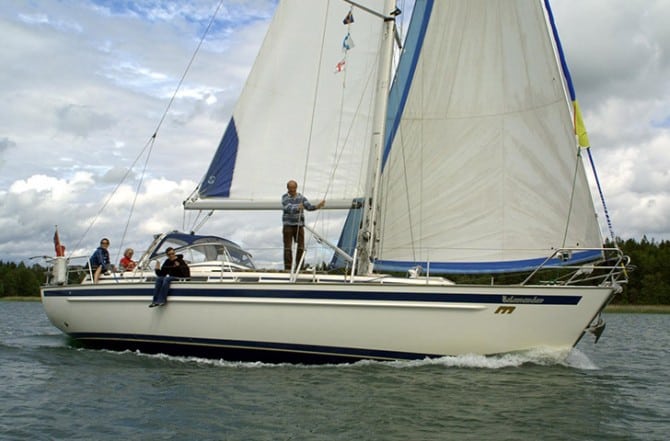
The Malö 41 is immediately distinguishable by its aft cockpit and Targa-style arch, which accommodates the mainsheet traveler. The arch preserves the advantages of an end-of-boom sheeting arrangement with few compromises. Although the 19-inch-long track for the mainsheet traveler is relatively short, it doesn’t impinge on cockpit space, and a rigid Seldén vang allows for fine trim on all points of sail. The mainsheet leads to a winch that’s mounted within reach of the helmsman.
The arch also provides a convenient support for a soft or hard dodger, a bimini top, or a full canvas cockpit enclosure for inclement climes. The curved glass of the Malö 41 sets it apart from its peers, as does the oversized, 30-millimeter stainless-steel tubing for stanchions and pulpits. It’s the only boat of the three that offers a shoal-draft option.
“In terms of beauty and function and storage and ease of maintenance, this was among the best of any of the boats we saw this year,” said Carol.
It features teak decks fastened over cored decks, something the BOTY judges didn’t like, but the builders go to great extremes to protect against water penetration. Most of the Malö’s deck hardware is bolted through fiberglass riser pads, not teak, leaving no path for moisture to reach the core. Where these risers occur, solid laminate replaces core; in some places, the hardware is bolted into aluminum flat stock encapsulated in the deck, eliminating through-deck penetrations. Owners have a choice of balsa or Divinycell core in the deck as well as the hull.
The hull is hand-laid solid glass below the boot stripe and balsa-core sandwich construction above. A molded rubstrake with an aluminum cap protects the hull. Three watertight compartments forward provide reassurance in the event of a collision. The main bulkhead, which acts as a ring frame, handles compression loads from the deck-stepped mast. Chainplates are bolted into long, solid-glass knees tabbed to the hull. Rig details include a split backstay (opening up access to the transom swim platform) and a removable inner forestay for a staysail or storm jib.
Malö, in business since 1939, builds fewer than 40 boats each year, and the yard encourages owner input, particularly regarding interior details. This flexibility is even more impressive when one considers that the hull/deck joint is bedded in 3M 5200, through-bolted, then glassed over. This bulletproof hull/deck joint requires that all machinery, equipment, furnishings, and independent tanks enter through the main companionway—a boon to the owner when the time comes to replace or service these items.
The options extend to the profile, as Malö offers two different transom shapes and two versions of each. The “classic” counter stern offers the advantage of added storage in the fantail lockers and an optional fold-down dive platform and swim ladder. Evoking a sleeker look, the reverse-counter version is available with or without an integral bathing platform and access steps.
The full hull sections never really turn flat, so the boat feels big for a 41-footer, both on deck and below. Malö offers four different interior arrangements, although these also can be modified to taste. The boat I sailed featured an L-shaped galley to port that was rich with nifty features, a convenient head and nav station to starboard, a well-lit saloon, a roomy V-berth and adjoining head forward, and a comfortable double cabin aft to port. A cruising sailor looking for an extra sea berth might choose the settee to starboard in lieu of the two armchairs featured on the version I sailed. Comparing the superior joinery work to that of a finely crafted piano, the BOTY judges regarded the Malö’s satin-finished mahogany interior as the finest of the three boats.
The boat’s onboard systems earned similar praise. “From an engineering perspective, engine access and installation were superb,” said Skip . “The raw-water strainer was under the sole by the galley, where you could get to it easily. The fuel filter was right under the companionway steps.”
A notable engine-installation detail on the Malö is the Aqua Drive, also used on the Najad and the Hallberg-Rassy. The flexible drive connection isolates the engine from the prop shaft, canceling alignment problems and allowing the engine to be installed on softer mounts, reducing vibration. With the 75-horsepower turbocharged Yanmar purring at 2,500 rpm, about 70 percent of its rated rpm, the Malö powered at 7.2 knots in smooth water. In reverse, the Flex-O-Fold propeller quickly stopped the boat; goosing the throttle in forward brought the boat quickly to her feet again. The optional bow thruster enabled the boat to shoehorn out of a tight slip that would require many boats her size to rely on warps.
In 8 to 10 knots of wind on Chesapeake Bay, I sailed the classic-deck version with a conventional full-batten main and a 140-percent roller-furling genoa. The Whitlock rod-linkage steering system, combined with a responsive underbody, gave an impression of nimbleness that was surprising for a boat that felt so solid underfoot. We tacked well through about 90 degrees; when cracked off the wind, the boat held about 6.8 knots with a desirable touch of weather helm.
The Malö had only a few items I’d wish to see changed. The boat I sailed had an anchor bow roller through the stem; although it made for a clean foredeck, for security in a dicey anchorage I’d prefer the optional deck-mounted twin roller. Carol recommended upgrading to a different release system for the removable inner forestay, one that didn’t leave such a prominent toe-stubber on deck and allowed the stay to be tensioned when a sail was set. In the cockpit, the proximity of the secondary winches to the primaries made it hard to operate both at the same time.
The Malö 41 is by the strictest measure a bluewater voyager that will go anywhere in comfort—no matter how cold or ugly the day. As sailed, the boat lists at $375,000.








